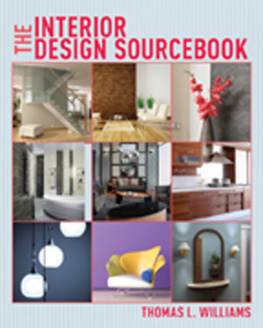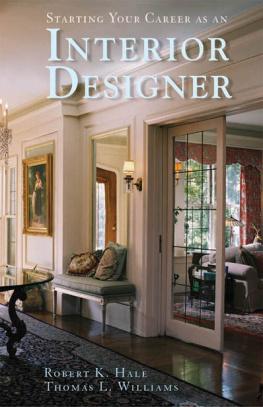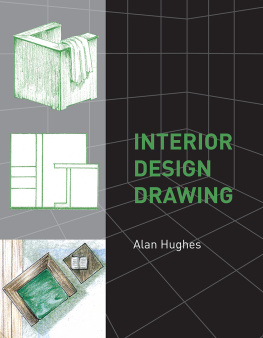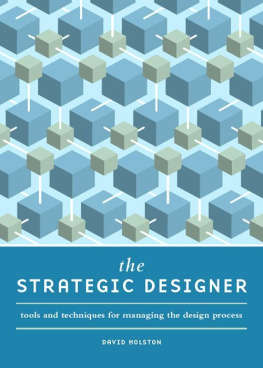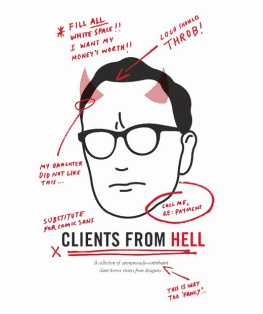INTERIOR
DESIGN
CLIENTS
THE DESIGNERS GUIDE TO BUILDING
AND KEEPING A GREAT CLIENTELE

BY THOMAS L. WILLIAMS

To Robert,
For supporting me in everything I do
2010 Thomas L. Williams
All rights reserved. Copyright under Berne Copyright Convention, Universal Copyright Convention, and Pan-American Copyright Convention. No part of this book may be reproduced, stored in a retrieval system, or transmitted in any form, or by any means, electronic, mechanical, photocopying, recording, or otherwise, without prior permission of the publisher.
14 13 12 11 10 5 4 3 2 1
Published by Allworth Press
An imprint of Allworth Communications
10 East 23rd Street, New York, NY 10010
Cover design by Kristina Critchlow
Interior design by Kristina Critchlow
Page composition/typography by Integra Software Services, Pvt., Ltd.,
Pondicherry, India
ISBN: 978-1-58115-676-8
eBook ISBN:9781581157413
Library of Congress Cataloging-in-Publication Data:
Williams, Thomas L., 1949
Interior design clients : the designers guide to building and keeping a great clientele / by Thomas L. Williams.
p. cm.
Includes index.
ISBN 978-1-58115-676-8 (pbk. : alk. paper)
1 Interior decorationMarketing.
2 Customer relations.
I. Title. II. Title: Designers guide to building and keeping a great clientele.
NK2116.2.W56 2010
747.068dc22 2010008022
Printed in Canada
Keep love in your heart. A life without it is like a
sunless garden when the owers are dead.
Oscar Wilde
FOREWORD
O ne of my earliest memories of explaining my mothers profession was correcting those much older than I. Oh, thats so nice that your mother is an interior decorator, they would proclaim. I was always strangely annoyed and exclaimed, Shes not a decorator, shes an interior designer. At the time, I did not know about the list of differences, but I knew my mother was a businesswoman first and an interior designer second.
As businesspeople first, we are empowered to be the creative geniuses that we were blessed to be. Without business prowess and sense, there are no clients to design for and there is no money to design with. It is no coincidence that many great artists only realized their full fame posthumouslyafter a businessperson successfully marketed and sold the fated artists works at their true values. As those who studied the great artists also know, many of these creative divas were unable to work well with others, rendering them completely useless in any client interactions. We do not want to be one of those divas.
We must be people-people. Often it seems that, in addition to countless other hats, interior designers must be armchair psychologistsassuaging clients fears and anticipating clients moves before they know the moves themselves. To be a good businessperson, it is not necessary to treat your clients like boardroom adversaries, but rather to take the finesse that you apply to each lovely room and to carefully cultivate and massage each client relationship to keep them and their friends coming back for more.
I was fortunate enough to meet Tom at, what else, a conference about the business of interior design. Immediately, one could see the grace and respect with which Tom approached his business, as it is equal to the grace and respect with which Tom approaches others. His communication style is impeccable and his self-presentation thoughtful.
As a follow up to Toms first book, Starting Your Career as an Interior Designer, this book more closely examines the lifeblood of our firmsthe client. In this book, he lets us, as the readers, get inside his head and carefully examine the gray matter that makes this interior designer/businessman/gentleman successful. The mixture of anecdotes, teachings, and case studies ensure that this book reads less like a dreaded textbook and more like a novel.
Most importantly, Tom begins the book with the first chapter on the Ideal Clientour foundation. It is not the client who is perfectly happy that you go to sleep worrying over and wake up thinking about, but rather the client that you knew was not the right fit for your firm, yet you decided to take on anyway. These are not bad people, but they are bad clients for you. Learning to identify and work with not only your good clients, but also your ideal clients will bring you great success.
We work in a fragmented industry. In fact, according to recent U.S. Census reports, most interior designers work for a firm of four or fewer. Chances are, if you are reading this book you are the head honcho of a firm of four or fewer. Chances also are that, as business owner and designer extraordinaire, you are not only tasked with being a creative director of your firm but also with ensuring that the clients are appropriately cared for, that the books are in good shape, that you are networking with the right people and in the right places, that you are up to speed on industry news and technologies, and responsible for a myriad of other tasks that keep you working late into the night.
We are in a client-centric industry. Without thinking of the client or the potential client at each step of the way, our firms suffer and under-perform. Tom walks through each client interaction and eloquently describes, often times through case studies, the best practices for gracefully and appropriately working with clients to achieve our penultimate goala successful project and, more importantly, a successful relationship that stands the test of time.
Without clients, we have no business. Without business, we have no meaningful creative outlet.
Alexandra C. Gibson CEO,
Gibson Design Management
Managing Partner, Gibson Design Group
Charlottesville, Virginia
INTRODUCTION
I n the world of professional interior design, clients reign supreme. Their every want and need is met and supplied by professional designers all over the country and the world. These clients can be demanding and particular about their selections and persnickety and tedious with observations about recently delivered products. They can also be delightfully inspiring and wonderfully receptive to the process of creation and implementation. The choice of how to proceed is up to you, the designer. It is you, after all, who must orchestrate and manage every aspect of this competitive and complex production we call interior design. There are a few questions you might ask to clarify what is needed to succeed.
When you work with your clientele, are you as pleased with the results as you should be and do they continue to come back to you for assistance? Do you find it difficult to create a marketing campaign designed to bring in the high-profit clientele other designers in your area seem to find everywhere they turn? Does it seem as if presentations become bogged down in minutia and last minute changes that you and your staff find difficult to control? Do orders become a behind-the-scenes nightmare for all concerned, and do you find deliveries are late or damaged in shipment? Are there times when you feel as if you have too many staff and other times when there just arent enough hands to go around? In short, do you feel as if you dont have any real control over clients and the decisions they need to make to get a project off the ground and completed in a timely and efficient manner? Well, youre not alone. How, you ask, is it possible to manage your client, their project, your business, and the multitude of tasks necessary to bring an interior design project to fruition? You see your peers out there working with clients all the time with smiles on their faces, skipping through the world of client and project management. Their clients seem to hang onto every word uttered and the collaboration appears to be made in heaven. What do these designers do to make it so easy, and why cant you have the same type of client? Actually, you can.
Next page

